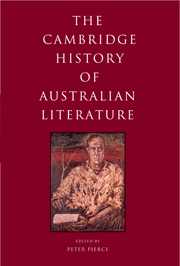Book contents
- Frontmatter
- Introduction
- FROM EUROPEAN IMAGININGS OF AUSTRALIA TO THE END OF THE COLONIAL PERIOD
- FROM THE LATE NINETEENTH CENTURY TO 1950
- TRAVERSES
- FROM 1950 TO NEARLY NOW
- 17 Publishing, patronage and cultural politics: Institutional changes in the field of Australian literature from 1950
- 18 Theatre from 1950
- 19 The short story since 1950
- 20 Scribbling on the fringes: Post-1950 Australian poetry
- 21 Groups and mavericks
- 22 The challenge of the novel: Australian fiction since 1950
- 23 The novel, the implicated reader and Australian literary cultures, 1950–2008
- 24 Nation, literature, location
- Select bibliography
- Index
- References
23 - The novel, the implicated reader and Australian literary cultures, 1950–2008
from FROM 1950 TO NEARLY NOW
Published online by Cambridge University Press: 28 May 2011
- Frontmatter
- Introduction
- FROM EUROPEAN IMAGININGS OF AUSTRALIA TO THE END OF THE COLONIAL PERIOD
- FROM THE LATE NINETEENTH CENTURY TO 1950
- TRAVERSES
- FROM 1950 TO NEARLY NOW
- 17 Publishing, patronage and cultural politics: Institutional changes in the field of Australian literature from 1950
- 18 Theatre from 1950
- 19 The short story since 1950
- 20 Scribbling on the fringes: Post-1950 Australian poetry
- 21 Groups and mavericks
- 22 The challenge of the novel: Australian fiction since 1950
- 23 The novel, the implicated reader and Australian literary cultures, 1950–2008
- 24 Nation, literature, location
- Select bibliography
- Index
- References
Summary
Foundations and genre
The origins of the novel and the settlement of Australia may both be located within the historical convergence of European industrialisation, colonisation and the Enlightenment in the 18th and early 19th centuries. It is uncertain what novels might first have been carried on board the tall ships with their human cargoes of convict workers and gaolers or how these were read within an Australian context, but it is clear that the exiles possessed higher average levels of literacy than the general population of Britain at this time. ‘And what books do you read?’, Freer demands of the 12-year-old Sylvia in Marcus Clarke’s convict narrative His Natural Life; the young girl responds: ‘Oh lots!’ including ‘Shakespeare’s Plays’, Milton, and the novels of Daniel Defoe, Henry Fielding and Jacques-Henri Bernardin de Saint-Pierre. Succeeding waves of enforced migrants and free settlers maintained the reading standard, while Education Acts from 1848 onward delivered almost universal literacy to the displaced and their locally born offspring, who went by the peculiar name of currency lads and lasses. An Australian reading public was thereby established early, as the imaginative interaction between texts and contexts made its first tentative gestures towards creative writing and ultimately literature. Literary critic Elizabeth Webby observed that printing presses arrived with the First Fleet but that it was several years before the expertise to run them could be assembled in Australia.
- Type
- Chapter
- Information
- The Cambridge History of Australian Literature , pp. 517 - 548Publisher: Cambridge University PressPrint publication year: 2009
References
- 2
- Cited by

